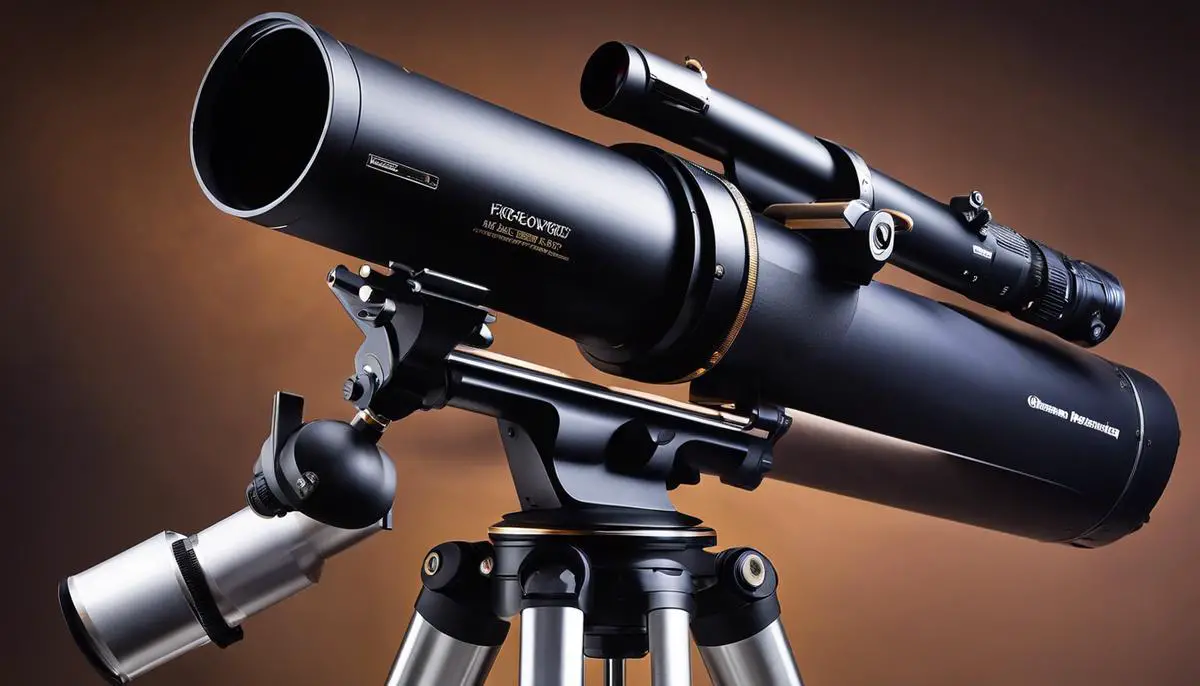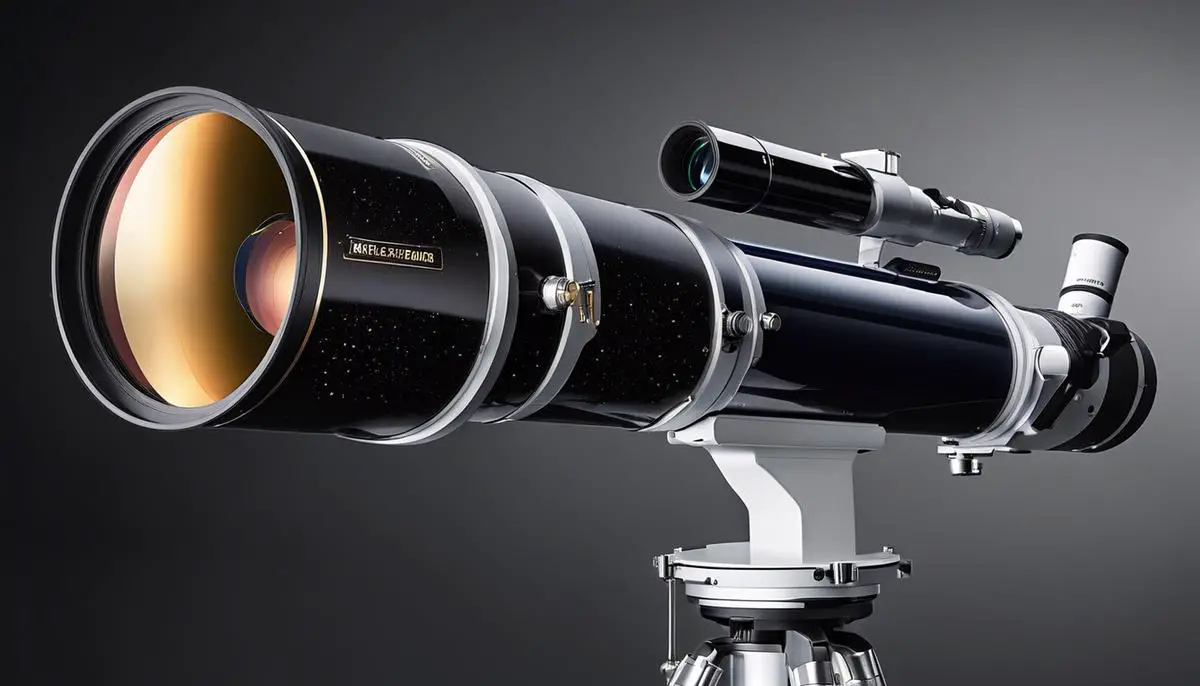Stargazing enthusiasts and amateur astronomers alike appreciate the quest for the clearest view of the cosmos. The choice of a refractor telescope is critical in this journey, as it serves as the gateway between our Earth-bound vantage point and the wonders of the night sky. In exploring the intricacies of optical quality and clarity, we embark on a quest to demystify the science and art behind these instruments. Through understanding the interplay of advanced glass materials, meticulous lens coatings, and the precise engineering of apertures and focal lengths, we begin to prioritize the features that transform a simple viewing experience into a breathtaking encounter with the stars. As we delve into the realm of apochromatic lenses and the importance of image stability, this exploration is more than a guide; it’s an invitation to unlock the full potential of the refractor telescope and gaze into the heavens with unparalleled clarity.
Optical Quality and Clarity in Refractor Telescopes
High-Clarity Refractors: Exploring Superior Optical Performance
Within the realm of telescopes, refractors are known for their exquisitely sharp images and high contrast. High-clarity refractors elevate these features to the next level, distinguishing themselves through several key attributes. These optical instruments employ superior glass, precision engineering, and advanced coatings to deliver a spectacular stargazing experience.
At the heart of a high-clarity refractor lies its top-notch optical glass. Unlike standard refractor telescopes, high-clarity models utilize extra-low dispersion (ED) glass or fluorite elements that significantly reduce chromatic aberration, the unwanted rainbow halo around bright objects that results from different wavelengths of light refracting at different angles. By diminishing this effect, ED glass enhances the resolution and contrast, providing users with crisp, true-color images of celestial wonders.
Craftsmanship plays a pivotal role in these telescopes’ stellar performance. High-clarity refractors are built with precision-engineered components that ensure everything is aligned perfectly. Their lenses are finely ground and polished to exact specifications, enabling them to capture and focus more light accurately. Some even boast a triplet lens design, which involves three glass elements working in concert to correct optical flaws, thus further improving image sharpness and clarity.
Another cornerstone feature is the use of high-quality coatings on the optical elements. Multicoated or fully multicoated lenses are standard in high-clarity refractors, which mean that each glass-air interface on the lens surfaces has multiple layers of coatings applied to minimize reflection. This maximizes light transmission, directs more light to the eyepiece, and prevents loss of image brightness and clarity, leading to a viewing experience that’s brighter and richer in detail.
Often, high-clarity refractors come equipped with superior mechanical components as well. Robust focusing mechanisms allow for fine adjustments that are smooth and free from backlash, giving astronomers the control needed to achieve the perfect focus on distant galaxies and nebulae. Coupled with a stable mount, these telescopes provide a vibration-free viewing that’s essential for high-magnification observations.
Additionally, accessibility features such as retractable dew shields protect the lens from fogging and block stray light, while rotatable focusers enable comfortable viewing from various positions. These thoughtful design touches show that high-clarity refractors are not only about outstanding optics but also user convenience and adaptability.
The combination of exceptional glass, precise construction, and advanced coatings sets high-clarity refractors apart, fulfilling the demanding requirements of serious astronomers and astrophotographers alike. While such quality comes at a premium, for those in pursuit of the most vivid and sharp celestial views, a high-clarity refractor is an investment that delivers unparalleled visual dividends.

The Role of Apochromatic (APO) Lenses
APO Lenses: The Clarity Revolution in Optical Technology
Achromatic versus Apochromatic – APO lenses take optical performance to new heights. Traditional achromatic lenses, typically found in standard optical devices, focus two wavelengths of light into the same plane. Yet, fall short of capturing the complete spectrum with flawless precision, leaving the door ajar for chromatic aberrations to impinge upon the image quality. Enter Apochromatic lenses, or APOs, brandishing their game-changing ability to bring three wavelengths of light into sharp convergence – relegating chromatic aberration to optical obscurity.
The inherent superiority of APO lenses lies in their construction. Often combining specialized glass types and advanced optical formulas, APO lenses are the quintessential instruments for achieving the pinnacle of true-to-life imagery. The result is a significant reduction in fringing and a leap in the accuracy of color rendition. This leap doesn’t merely nudge the bar; it propels it, enabling professionals and hobbyists alike to witness the world with an unprecedented level of detail and authenticity.
A deeper dive into the anatomy of APO optics reveals the underlying nuances that make these lenses transformative. The strategic incorporation of extra elements within the lens assembly corrects for spherical aberration and coma, two villains in the optical arena known for degrading the crispness of the image. With these corrected, APO lenses ensure that light converges at the right point, resulting in a razor-sharp focus and an impeccably clear picture.
Indeed, APO lenses don’t operate in isolation. Their heightened clarity is also a function of the state-of-the-art coatings applied to their elements. These multi-layered coatings are not just ornamental; they are fundamental. They serve to bolster light transmission while squashing unwanted reflections that can cloud and tarnish the visual experience. Coupled with an APO lens’s core capabilities, these coatings consolidate the lenses’ status as the zenith of optical clarity.
The reverberations of APO lens technology resonate beyond uncompromised image sharpness. Their adoption across various fields – from astrophotography to wildlife observation – has set new standards in high-fidelity imagery. For nature enthusiasts, APO lenses unlock the subtleties of wildlife and landscapes, revealing the artistry and dynamism of nature’s palette. Astrophotographers, on the other hand, gaze through APO lenses to pierce the veil of the cosmos, capturing celestial phenomena with jaw-dropping clarity.
Delving into the world of high-clarity optics, APO lenses underpin a revolution that transcends mere technical advancements. They are at the helm of a movement – a forward march towards a future where the barriers between reality and representation are increasingly diminished. For the ardent observer, APO lenses are not just a choice; they’re an imperative – for what is the purpose of observation if not to see the world as it truly is, in all its resplendent detail and color?
As the landscape of optical technology continues to evolve, APO lenses stand out as a beacon of excellence. They reaffirm that clarity is not an optional luxury; it’s the cornerstone of genuine, immersive observation. With APO lenses bringing forth a new era of visual mastery, attendees of the optical symphony can sit back and relish a performance where every note is crisp, every chord is pure, and the entire composition is delivered with impeccable clarity.

Best Refractor Telescope Brands for Image Clarity
Clear Imaging Champions: Leading Brands at the Forefront
In the realm of optical technology, certain brands have carved out a reputation for achieving the pinnacle of image clarity. When discussing leaders in this field, we cannot overlook the contributions of Nikon and Canon – two powerhouses jockeying for the top position with their state-of-the-art camera lenses and innovative technologies.
Nikon, a veteran in the optics game, is renowned for its NIKKOR lenses which employ ED glass to combat chromatic aberrations, rendering images with astounding sharpness and true-to-life colors. The dedication to precision craftsmanship is evident in their handling of light across the entire frame, a feat that makes Nikon a go-to choice for professionals and enthusiasts alike.
Canon has countered with its L-series lineup, boasting fluorite and ultra-low dispersion elements to achieve crisp images that professional photographers demand. A proprietary Subwavelength Structure Coating (SWC) and Air Sphere Coating (ASC) on the lenses cut down on flare and ghosting, ensuring remarkable contrast even in challenging lighting conditions.
Stepping outside the traditional DSLR market, Sony has emerged as a formidable contender with its G Master series, pushing the envelope with industry-leading resolutions and bokeh effects that have caused quite a stir. Sony’s embrace of mirrorless technology has propelled them to a competitive position, challenging the incumbents to adapt or face obsolescence.
Meanwhile, Zeiss lenses, with their storied history, continue to be synonymous with excellence and superior optical performance. With stringent quality control measures and the use of high-grade glass, Zeiss lenses provide unmatched detail and contrast, solidifying their status among aficionados of fine optics.
In the specialized sector of telescopes, brands like Celestron and Meade dominate, making significant strides with Schmidt-Cassegrain and APO refractor telescopes. These instruments, with their advanced optical designs, such as the StarBright XLT coatings on Celestron telescopes, offer unparalleled celestial viewing experiences, capturing the imaginations of stargazers around the world.
It’s no secret that astronomical optics have benefited from the technological breakthroughs brought forth by these industry leaders. Furthermore, emerging players in the market should not be underestimated, as their fresh perspectives and innovations continually push the boundaries of what’s possible, ensuring an exciting future for optical technology.
The quest for the holy grail of clear imaging doesn’t end with the brands mentioned. As manufacturers strive for excellence, the consumer reaps the benefits of a wide array of choices suited to diverse requirements and preferences. From the tranquil observatory out in the countryside to the kinetic activities of a bustling sports event, high-performance optics have found their place. The only question that remains is not if, but how these brands will continue to shape our view of the world and beyond.

Price vs. Performance for Refractor Telescopes
Striking the balance in investing for optimal clarity is a delicate endeavor, akin to blending art with science; one must chart a course that both aligns with financial constraints and refuses to compromise on the high fidelity required by discerning viewers and professionals. When it comes to choosing the right equipment, it is the perfect union of premium materials, meticulous assembly, and top-tier technology that defines the upper echelons of optical performance.
It is crucial to consider the oft-overlooked aspects of optical equipment that contribute to unparalleled clarity. For example, specialized anti-reflective coatings—such as those used in Swarovski’s EL binoculars—play a pivotal role. This technology not only enhances the visual experience by increasing light throughput but also protects against the wear and rigidity weather can impose, thereby justifying a portion of the investment.
Additionally, the integration of adaptive optics, which corrects atmospheric turbulence, is increasingly making its way from the realm of professional observatories to consumer products. Such advanced systems can offer significant improvements in image clarity but require substantial investment, which enthusiasts must weigh against their pursuit for peak performance.
The longevity and upgradeability of optical equipment should also factor into investment considerations, particularly when considering the long-term value. High-grade telescopes and lenses often offer modular designs, allowing for incremental upgrades like superior eyepieces or additional filters, ensuring they remain state-of-the-art without necessitating a complete overhaul.
One must also scrutinize the warranty and service offerings of high-end optical brands. Premium brands such as Leica and Zeiss extend generous warranties and repair services, bolstering the long-term viability of their products. This aspect can often be undervalued, but savvy investors recognize that this support can substantially mitigate future costs associated with maintenance and repair.
Finally, it is imperative to navigate the market with an acute awareness of the diminishing returns when reaching the pinnacle of clarity. While top-of-the-line optics deliver unmatched clarity, there is a threshold beyond which additional investment yields marginal improvements that may be imperceptible to all but the most specialized users.
Investors must therefore calibrate their expenditures, seeking the sweet spot where cost, quality, and performance intersect. Committing to such a philosophy ensures that one’s investment in achieving optimal clarity is both judicious and justified, securing equipment that will continue to dazzle and deliver exquisite detail for years to come.

Mounts and Stability for Clear Observation
How Do Mounts Influence the Clarity of Your Telescope?
Astronomy afficionados and stargazing novices alike know that the path to a crisp, celestial tableau starts not just with the telescope’s lens or mirror, but with its mount. This vital piece of engineering is more than just a tripod or a stand; it’s the foundational component that can either enhance or compromise the clarity and precision of your observations.
For a telescope, the mount is analogous to a musician’s stage – without stability, the performance suffers. Mounts come in two primary flavors: altazimuth and equatorial. Altazimuth mounts allow for easy vertical and horizontal movement, making them ideal for casual sky scanning. In contrast, equatorial mounts are aligned with the Earth’s axis, providing a steady tracking of celestial bodies as they move across the sky, critical for long-duration observations and astrophotography.
A mount’s construction must ensure rock-solid stability. Any vibrations from wind, an unsteady hand, or even the ground can result in a jittery image. Advanced mounts often feature computerized tracking systems, utilizing motors to compensate for the Earth’s rotation. This technology maintains the telescope’s focus on a star or planet for extended periods, providing an uninterrupted window to the cosmos.
Mounts influence clarity not only through stability but also by allowing for precise adjustments. A high-quality mount enables micro-adjustments, allowing users to dial in the focus on distant galaxies or nebulas with finesse. Without this level of control, one risks blurring the fine details that space has to offer.
Telescope users should also consider the portability of their mounts. While a heavy, solid mount may offer the best vibration damping, it can be impractical for those who seek out remote stargazing spots. Portable mounts that fold or dismantle without sacrificing stability offer a clear advantage for mobile astronomers.
Finally, one cannot overlook the synergy between a telescope and its mount. A mount must match the telescope’s weight and size specifications to function effectively. Too light a mount under a heavy telescope will be unsteady, just as an overly robust mount can be overkill for a lightweight scope, making for cumbersome setup and adjustments.
The pursuit of clarity in telescopic observations demands attention to the minutiae, and the mount is no exception. Ensuring that your telescope sits atop a fitting, impeccably engineered mount will unlock the full potential of your optic, laying out the heavens before you with the utmost sharpness. Whether tracking the slow march of planets, or capturing the fleeting brilliance of a comet, the right mount is key to a clear and steady gaze into the cosmos.

Future Innovations in Refractor Telescope Clarity
Technological Advancements on the Horizon: A Crystal Ball into the Future
As technology enthusiasts eagerly scan the horizon for what’s next, there exists a palpable buzz surrounding upcoming advancements that promise to redefine our daily lives. Riding on the coattails of groundbreaking innovations and relentless research, the field of technology is poised for a quantum leap into the future.
In the not-so-distant future, quantum computing is expected to shatter current computational limits. With its capability to solve complex problems at unprecedented speeds, it will unlock new possibilities in drug discovery, logistics, artificial intelligence, and more. By leveraging the peculiar principles of quantum mechanics, quantum computers will process information in ways that traditional computers could never achieve.
Artificial Intelligence (AI) is on the brink of pushing the boundaries of machine learning and sophisticated problem-solving. With advancements in neural networks and data analysis, AI systems will become more intuitive, emulating human reasoning more closely. This could revolutionize areas ranging from predictive analytics to autonomous systems, and even enable advances in tackling global challenges such as climate change and disease outbreaks.
In the realm of connectivity, 6G technology is the next frontier, poised to succeed its predecessor, 5G. Promising faster data speeds, lower latency, and richer connectivity experiences, 6G will foster innovations such as holographic communications, advanced Internet of Things (IoT) ecosystems, and enhanced mobile broadband services. As connectivity becomes even more seamless, smart cities will evolve with intelligent infrastructure and finely tuned, responsive services.
Health tech is another field set for dramatic progress. Wearable technology will go far beyond tracking steps and heart rates, evolving into tools that monitor a wider range of physiological and even emotional health indicators in real-time. Advancements in genomics and personalized medicine will enable individually tailored treatments and preventative interventions, potentially ushering in a new era of healthcare.
Furthermore, the realm of space exploration and technology continues to surprise. With rocket reusability becoming more sophisticated and plans for Moon bases and Mars missions taking shape, the dream of a multi-planetary human presence is inching closer to reality. Developments in propulsion technology, space habitats, and life-support systems will play a critical role in the viability of long-term space habitation and interplanetary travel.
Not to be overlooked, the sustainability technology sector is witnessing a surge in innovation as the world grapples with environmental concerns. From alternative energy solutions such as advanced solar panels and wind turbines to carbon capture and storage methods, efforts are ramping up to mitigate the effects of climate change. Smart grid technology is also expected to become more prevalent, optimizing the distribution and use of electricity in an eco-conscious manner.
Finally, augmented reality (AR) and virtual reality (VR) are set to mature and converge into extended reality (XR). These technologies will see widespread adoption, augmenting everyday experiences across education, shopping, social interaction, and professional training. As hardware shrinks and software advances, immersive virtual environments will become a routine part of navigating the physical and digital worlds.
As these technological advances coalesce, it’s evident that we’re standing on the brink of a transformed world. In this era of innovation, the only certainty is that technology will continue to influence every facet of human endeavor, advancing society into a future rich with possibilities. With the roadmap of future tech trends unfolding before us, the anticipation is palpable, and the potential, limitless.

The universe is an ever-unfolding tapestry of celestial beauty, waiting to be revealed in sharp relief by the lenses of our telescopes. As we stand at the intersection of present technology and future innovation, we are reminded that the pursuit of clarity in astronomical observation is both a timeless endeavor and an evolving challenge. With each advancement in refractor telescope design, from sophisticated lens crafting to cutting-edge mount engineering, we edge closer to the stars, bringing the cosmos into our backyards with increasing precision. The journey of selecting and using a refractor telescope is not just about acquiring a tool for viewing; it is about fostering a deep connection with the infinite and enabling our eyes to witness the universe in its truest form. Embark on this celestial quest armed with knowledge and anticipation for the wonders that clarity will reveal.
![]()
